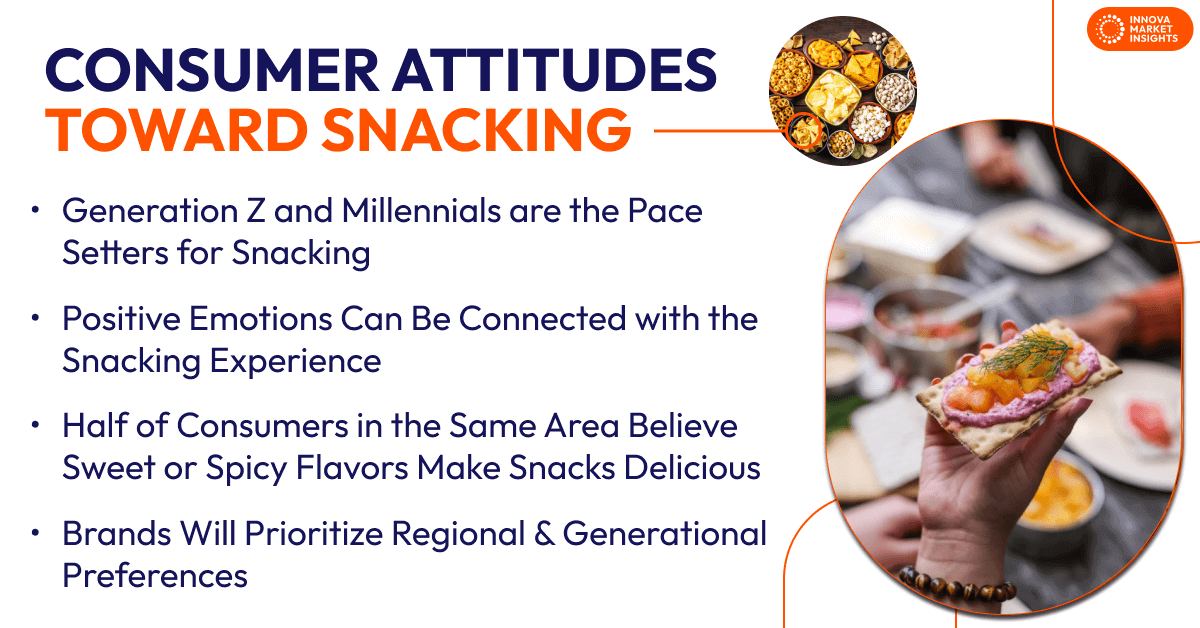August 18, 2025 – Consumers are making choices in line with their lifestyles and regional availability. For brands, there is a clear need to innovate and position products with evolving snacking preferences and behaviors. To understand this better, Innova Market Insights has compiled a series of statistics and data about consumer attitudes toward snacking on a global scale. Condensed into this report lies a wealth of information to demonstrate key areas and drivers in indulgent and healthy snacking.
Frequent Snacking in 2025
There are different types of snackers. For example, of those who consume snacks on the regular and more often, Generation Z and Millennials are the pace setters compared to Generation X and Boomers. While that may be a more general observation, it is impressive nonetheless. As with consumers in the North American and Asia Pacific regions being the biggest groups who snack more typically by region (coming in at 59% and 57%), this is more than consumers from Europe (44%) by comparison.
Millennials and Generation Z have a higher possibility of replacing main meals with snacks than Boomers though, as they eat snacks at breakfast, lunch, and dinner. Those in Latin America and Asia Pacific however, consume snacks at breakfast and dinner more than consumers in other regions. Around a fifth of snackers in North America love a late-night treat, with Millennials and Generation Z again being the main culprits. Interestingly, almost half of the consumers in Asia Pacific and two-fifths of consumers in Latin America tend to replace a meal with snacks every day. While in Europe, almost a third of people never replace a meal with a snack.
Research on popular categories for snacking across the whole day shows that more than half of the consumers say they eat salty or savory foods and cookies as snacks. To break this down regionally, in Latin America, bread is a popular snack, while European consumers go for chocolate and sweets. Meanwhile, in Asia, consumers choose plant-based snacks and in North America, salty foods are widespread. Demographically, Generation Z and Millennials tend to go more for drinks as a snack (juices and carbonated drinks), whereas Generation X and Boomers are more likely to pick nuts and fruit. The most common snacking occasion at the moment is at home, where a lot of staple food is considered snacks and sensory aspects are the top considerations when purchasing.

Snacking and Positive Emotions
Positive emotions can be connected with the snacking experience. To demonstrate this further, a third of consumers answered that they experienced craving before snacking, but this emotion lessened quickly after snacking. Key triggers that lead to these moments are anxiety and stress, while happiness, calmness, and relief are the emotions felt after eating. All of which become elevated after having a snack. Elsewhere in other food categories, bread and other bread products are associated with comfort by a third of consumers globally, whereas about one-quarter of consumers say calmness and relief drive their consumption of vegetables.
Perceptions of Indulgent and Healthy Categories Are Divided
Consumers associate chocolate and sugar confectionery, along with salt and savory foods as indulgent, while fruit and vegetables are considered less so and more healthy. However, differences exist where some food and beverages fall into neutral categories. For example, meat-based food is considered by German consumers as indulgent, while those in Mexico do not feel the same. Then you have Mexicans who consider bread and bread products indulgent, while Indian consumers do not think they are. Regionally and culturally, this can also differ, as meat-based snacks may be considered indulgent by using naturally sweet meat and adding spiciness, particularly in the Asia Pacific region. Yet, almost half of consumers in the same area believe sweet or spicy flavors make snacks delicious for them.
In other categories, such as bread products, these are made indulgent by incorporating both crispy and soft textures. While in hot drinks, indulgence is implicated by enhancing their creamy and rich texture. Ultimately, cravings, enjoyment, and reward offer a level of gratification that appeals to consumers. Beyond this, snacks are generally uplifting and energy-providing and remain the key to rewarding consumers globally.
What Makes a Snack Healthy?
Healthy categories are mainly fresh or slightly processed products. To contextualize this further, Innova’s research found that 81% say that chocolate and sugar confectionery are indulgent but not healthy in their opinion. This was closely followed by salty and savory food. By contrast, those researched felt that hot drinks are made healthy by using natural and flavorful ingredients instead of adding sugar, as 37% felt that by limiting ingredients that were bad for them made the snacks healthier. The same can be said for carbonated drinks, which are deemed healthy by integrating vitamin C, collagen, and superfood. In fact, 22% said that by adding functional ingredients that can boost nutrition to a drink can make it feel healthier. Consumers choose healthy categories as a habit, especially when they want something to still their hunger and give energy. Beyond keeping hunger away, many feel that healthy snacks can boost nutrition and improve mood.
What’s Next for Consumer Attitudes Toward Snacking?
It is fair to say that snacking is more frequent in 2025, especially among younger consumers in North America and Asia Pacific regions. Beyond traditional snack times, many people now snack during mealtimes, particularly in the Asia Pacific and Latin America. This will give rise to the creation of “hybrid snacks,” which will blur the lines between meals and snacks. Concentration is now firmly focused on nutritious, convenient options suited for both snacking and light meals. No doubt, brands will prioritize regional and generational preferences, driven by both emotional and functional needs.
Sensory attributes such as flavor and texture – especially sweet, salty tastes and crunchy, creamy textures are becoming more common. Should these outweigh health or convenience, then they will likely be preferred by consumers. Products that contain a rich texture or a bold flavor can penetrate purchasing trends in the market if an aligning attribute for nutrition can be added. This is because consumers seek healthier snacks with reduced sugar and fat, and featuring claims for natural ingredients and added nutrients such as protein, fiber, and vitamins.
This article is based on Innova’s Consumer Attitudes Toward Snacking – Global report. This report is available to purchase or with an Innova Reports subscription. Reach out to find out more
